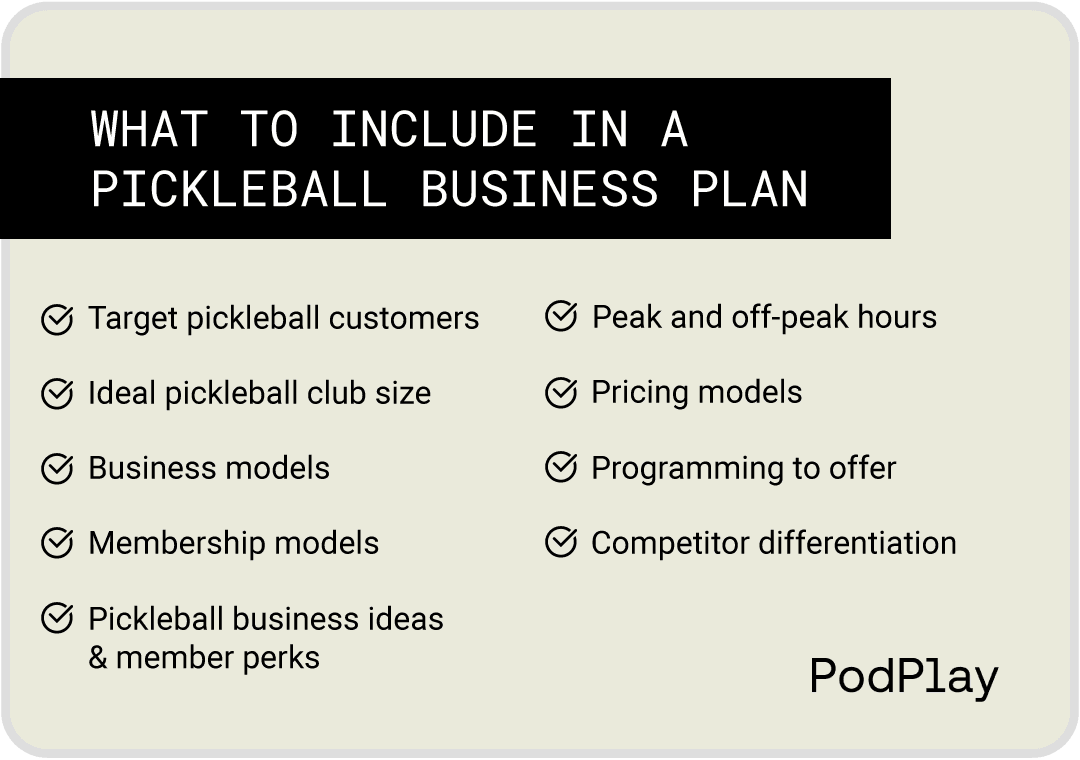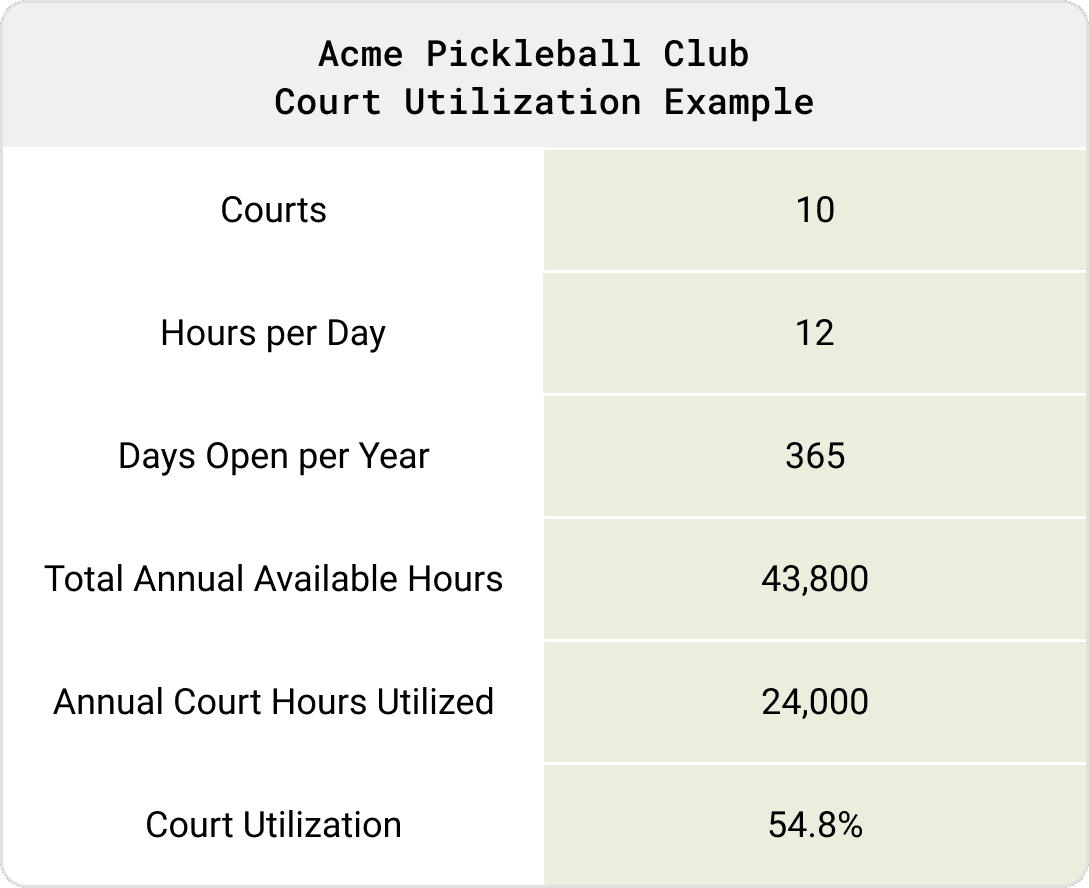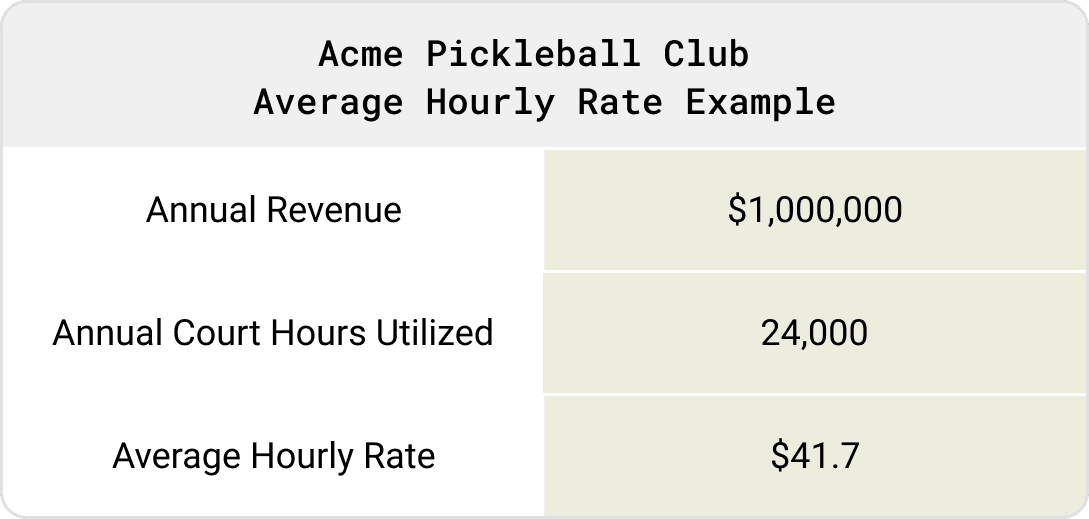

 Starting a pickleball business requires careful planning – from drafting a business plan and choosing a location to setting pricing models and programming to marketing and running a profitable pickleball club. In this guide, we’ll cover each of these and much more to help you launch a successful club.
Starting a pickleball business requires careful planning – from drafting a business plan and choosing a location to setting pricing models and programming to marketing and running a profitable pickleball club. In this guide, we’ll cover each of these and much more to help you launch a successful club.
Updated March 2025 with new learnings from the past 12 months and additional insights provided by the industry experts at Johns Design and Consulting and StackEleven.
In their 2023 State of Pickleball: Participation & Infrastructure Report, Pickleheads and SFIA estimated there were 12,081 Pickleball facilities in the U.S. with an average of 4.3 courts per facility, for a total of 51,937 courts. Over 70% of these courts were temporary. The report estimated that the U.S. would need to spend $900 million over 5-7 years to build 25,800 dedicated courts to reach one dedicated court per 500 participants.
In the 2024 update, Pickleheads and SFIA reported that pickleball participation grew an astonishing 51% year over year and 223% over three years. With over 19 million participants, pickleball is fast approaching tennis as the most popular racquet sport in the United States.
Brandon Mackie, Co-founder and COO of Pickleheads, said, “we can see the pickleball industry has responded to the court shortage challenge by adding infrastructure, with dedicated pickleball facilities growing 55% year-over-year. Still, there remains a long road of investment ahead with $855 million needed to construct courts over the next 5-7 years.”
If you are one of the entrepreneurs emerging to create the supply needed to balance the overwhelming demand for courts, this guide is for you!
Table of Contents
Whether starting a new pickleball business plan or refining an existing one, you’ll want to translate your pickleball ideas into a clear vision, market understanding, informed financial strategy and operational plan, and benchmarks to track performance. This is especially true if you hope to secure financing through loans, investors, or partners.
This guide covers essential topics, including who your target customers are, ideal pickleball club size, finding the right location for your club, profitable pickleball business models, club membership types, peak and off-peak hours, pricing models, club programming, player development pathways, critical sources of differentiation, how to run a profitable club, and marketing strategies to grow your pickleball club.
Our insights on building a successful pickleball business plan come from our experience as an operator of sports clubs and provider of pickleball court reservation and club management software to the most tech-forward pickleball clubs in the world.

If you have any questions or additional resources to include in support of entrepreneurs creating their own pickleball business plan we want to hear from you.
The best pickleball clubs have a business model that matches the needs of the target customer profile. Aspiring club owners should start their pickleball business by asking: who is my target customer?
Since different customer segments have very different needs, it's essential to understand the motivations of the most common types of pickleball players. The following list of characteristic customer segments is non-exhaustive and meant to illustrate differences in their needs:

Professional pickleball players:
Regular pickleball players:
Social players:
Casual or new players:
There is no one-size-fits-all answer to this question. A club with two courts is very different from a club with 24 courts, and other elements like staffing and programming will follow from club size. Factors to consider when picking the right size for your club may include:

Getting 500-1000 players per week through your door is quite plausible in a city with a population of a million. Less so in a town of 10,000 residents. When building your pickleball business plan, look closely at the following market considerations to determine the ideal size of your pickleball club:
The goal is to find a location that's right sized to the opportunity, accessible to your target market, visible to potential new players, and financially viable for your business model.
While the saying "location, location, location" might seem cliché, it's especially true for pickleball facility site selection. The right location and physical space that checks all the boxes can set your facility up for long-term success. But overlooking key elements like ceiling height or court dimensions simply can't be fixed once you've signed a lease.
Always work with a commercial real estate professional who understands the unique needs of sports facilities. If you’re partnering with a pickleball facility consulting firm, they can help you evaluate potential sites.
The 22-Minute Rule
Research shows that most players are willing to drive about 22 minutes to play pickleball. This creates a natural boundary around potential locations and should guide your search. Remember that while a location might look perfect on a map, it’s also important to consider how traffic patterns, accessibility to major roads, and ongoing construction affect actual drive times.
Visibility and Accessibility
It’s true that dedicated players will seek out well-run facilities regardless of location, but the best locations combine good visibility with easy access, such as:
Must-Have Space Requirements
The physical requirements of a pickleball facility are non-negotiable and should be carefully evaluated before signing a lease.
Sound Management
Pickleball generates a lot of noise, and managing this is critical for neighborhood relations and player experience. While there are many sound mitigation strategies that can be used, like acoustic panels and specialized insulation, remember that it’s usually easier to manage sound in a standalone building compared to a shared space.
A well-designed pickleball facility will attract discerning players that are willing to pay a premium for a better playing experience. This is why it’s so important to consider all aspects of pickleball facility design and space planning before you begin your real estate search.
Club owners should align their business model with their target customer profile. At a high level, there are two main models (with lots of variations that fall on a spectrum):
Your pickleball club's business model will inform the membership strategy, court pricing, and programming.
Many traditional athletic clubs are membership-only. A members-only pickleball business model yields certainty of recurring revenue for the club but is generally the wrong price for many customers and does not discriminate between peak and non-peak hours. Some members will use the club a lot and get a consumer surplus. Others will use the club very little. A very profitable membership model may sometimes depend on "breakage," i.e., some members are not using the facility.
Generally, membership-only models in pickleball are more common at very high-end clubs that seek to replicate an exclusive country club-like offering and can work in that context. Outside of the high-end country club style model, membership-only models need to find a way to balance the needs of the customers and the club.
Membership models range from on-demand only (no membership) to membership only. The vast majority of clubs will involve a mix of membership, programming, and on-demand bookings. There is no one answer to membership, but the common theme of effective and sustainable programs is that they deliver value to customers and profitability to the club owner.
Membership provides club owners with recurring revenues with a high degree of certainty. There is a strong appeal to knowing you have a minimum amount of revenue booked for the month before it even starts. Usually, a club will offer court capacity to members at discounted rates in exchange for that certainty. If you want to charge high membership dues, you must either have excess demand for your capacity, deliver a lot of value to your members, or both.
A simple framework for evaluating membership is comparing all-in savings for members versus non-member rates. The table below shows three oversimplified scenarios (discounted court bookings and no other perks) to illustrate this framework.
 When marketing memberships, it is important to define the value to your customers clearly. In Scenario 1 above, the club could market this membership by saying, "Want to play more than six hours of pickleball per month? Save money with a membership!"
When marketing memberships, it is important to define the value to your customers clearly. In Scenario 1 above, the club could market this membership by saying, "Want to play more than six hours of pickleball per month? Save money with a membership!"
The easiest value proposition to communicate is “unlimited free play” but we would counsel club owners pursuing “all you can eat” membership models to include appropriate limits (e.g. number of concurrent reservations held, hours per day) to prevent abuse and make sure all members have access to courts.
It is important for club owners to right-size the number of memberships sold. While selling a lot of memberships is great for recurring revenue, if there is little capacity for those members to use, the members will be disappointed. Capping the number of memberships and creating a waitlist can effectively incentivize membership sign-ups and retention. Members will think twice about canceling if it means they go to the back of the waitlist line.
From a club standpoint, it is important to consider the amount of consumer surplus delivered to members and the opportunity cost of the court time members use. Club owners will generally be willing to offer a discount in exchange for more revenue certainty. Still, they will be particularly willing if the capacity used by members is not likely to be used by non-members.
Creating memberships that offer discounts or free play during hours with lower utilization can be a fantastic win-win for customers and clubs alike. Consider using membership to balance demand across different hours and days of the week.
We encourage club owners to think hard about membership benefits that allow free court reservations, particularly unlimited ones. In addition to the detailed free rider problem, we have seen situations where customers hoard multiple reservations to retain the opportunity to play, effectively removing the capacity that paying customers might otherwise want.
If offering free court time, club owners should limit the number of reservations a single customer can hold at any given time, consider using bill-splitting with non-member fees, and institute penalties for repeat no-shows.
Demand for pickleball courts can differ dramatically. For most clubs, filling your courts on a Saturday night is easy, while doing so on a Monday morning is not. Because demand differs by time and day of the week, offering lower prices during off-peak hours can be a good way to incentivize cost-sensitive customers to play during lower-demand periods. Most customers will default to booking during peak hours without a pricing incentive.
The fundamental property of court time for club owners is: use it or lose it. You don't get a second chance to sell Court 1 at 3:30 pm last Friday. This quality makes optimizing the utilization of available court inventory crucial to the success of your pickleball club.
Both off-peak pricing and membership can be used to help balance utilization across the week. Memberships that target off-peak hours (like a morning membership) can be a great way to create value for cost-sensitive, time-sensitive customers who want to play a lot of pickleball!
When choosing a pricing model for your pickleball club, operators often make trade-offs between the venue's and customer's needs. If everything else is held equal, a venue will favor higher prices, no free riders, and certainty of recurring revenue. Customers will favor lower prices, simplicity of use, and flexibility.
In our experience, customers like pricing simplicity, dislike any uncertainty about charges, and will not always know in advance who they are playing with. If there is an opportunity to free ride on someone else's discounted pricing, a subset of customers will find a way to take advantage.
All club pricing models involve trade-offs. What is good for the customer may not be good for the club and vice versa. You will want to choose a model that balances the needs of customers and the club because customer-friendly models will ultimately yield happier customers and higher utilization. Historically the two main pricing models have been:

PodPlay has developed a unique hybrid third model that offers the best of the court and spot models. Court+ pricing with bill splitting allows the booking customer to invite other players and cover for them, or invite them to pay for their share of the bill. A hold is put on the booking party’s card when the reservation is made, with final splits determined and processed at the time of the reservation based on who accepted the invitation. The booking party doesn’t need to know in advance who they are playing with. Member and non-member pricing rules are applied to the relevant parties, solving any free rider problems. And with the bill split in the app, your customers do not have to Venmo or PayPal their friends after a match.
Choosing a pricing model for your pickleball business to increase profitability should be linked to your approach to club membership and peak versus off-peak hours. Pickleball pricing models are complex because members play for discounted or free, and there are potential free rider problems. Membership that focuses free play on open plays can be an effective way to limit free rider problems. Open play is, by definition, per spot, so member benefits are conferred to the member but not their non-member companions.
Pickleball is widely known as one of the most social sports. It is easy to pick up for players across a wide age range, making it very approachable. The vast majority of play is doubles, involving at least four players. The combination of a healthy, approachable, inherently social game means offering the right mix of programming, which is crucial to the success of your pickleball club.

Finding the balance between business and community
JDC has observed facilities that struggle when they prioritize community preferences over sound business practices.
"We recently spoke with a (non-JDC) facility that's really struggling because they prioritized community feedback over strategic business decisions," explains West Shaw of JDC. "They eliminated scheduled open play because members said they ‘didn't like it.’ But the purpose of open play is so that the community all goes at the same time–so you have other people to play with. Without open play, the community experience suffers and revenues dwindle."
This facility is now changing their approach, but they're already "far behind the eight ball" in West's assessment. The lesson is clear: while community input is valuable, facility operators must balance responsiveness with maintaining operational best practices.
One of the most overlooked aspects of successful pickleball facilities is implementing a structured player development funnel. Facilities need a clear pathway to help beginners progress toward intermediate skill levels–specifically to reach the coveted 3.5 rating.
"The 3.5 player is your highest returning value customer. They can play in every event, continue taking lessons and clinics, build community, and spend the most money at your facility," notes West Shaw, COO at Johns Design & Consulting.
Developing players to this level doesn't happen by accident. Rather than offering disconnected programming, successful clubs create step-by-step pathways for player improvement:
While many early-mover pickleball clubs today benefit from being "the only game in town," this is not likely to be a long-term source of competitive advantage. As more supply enters the market, we will move towards a future equilibrium where players have multiple options and clubs compete in their offerings. In this future state, differentiation will become more important.
Key sources of club differentiation include:

Total revenues are a function of two variables: court utilization and average hourly rate. At $50 per hour, a 10% increase in utilization equates to more than $200,000 a year for a ten court pickleball club.
Court utilization and average hourly rate are the essential inputs to your club’s revenue equation. Small increases in these inputs can lead to large increases in revenue. All of the business decisions you make for your pickleball club - everything from membership structure to peak vs off peak pricing to programming - can be improved if viewed through the lens of court utilization and average hourly rate.
Pickleball Court Utilization
Court utilization for a pickleball club is equal to the amount of court hours utilized by customers divided by total available court hours. Annual available court hours are a function of the number of courts, hours open per day, and number of days open per year.

Average Hourly Rate
Average hourly rate for a pickleball club is equal to total revenue for a period divided by the court hours utilized by customers during the period. Club operators can think of this as a measure of how efficient their court utilization is. Activities that generate a lot of revenue per court will tend to drive the number up, while other activities that promote utilization through incentives or giveaways (e.g. free trials) will tend to depress average hourly rate.

How to Bend the Revenue Equation to Your Advantage
Pickleball clubs can Bend the Pickleball Club Revenue Equation using techniques that simultaneously increase court utilization and average hourly rate such as:

For a deep dive on other drivers of pickleball club profitability, including the cost side of the equation, we recommend reading Pickleball Facility ROI: A Guide to Revenue, Costs, and Profitability.
Growing a pickleball club isn’t just about having great courts and a strong community - it requires a well-executed marketing strategy to attract new players, fill up memberships, and establish your club as the go-to spot for pickleball enthusiasts. StackEleven’s Ultimate Pickleball Club Marketing Playbook is the best resource we have seen on the subject.
It breaks down the most effective marketing strategies used by top pickleball clubs, helping you maximize exposure, increase court utilization, and boost long-term success. Check it out to learn more about:
By implementing a combination of Paid Ads, PR, Social Media, and SEO, your club can experience rapid and sustainable growth. All of these strategies can be amplified through use of user-generated content from PodPlay Pro Monitors.
This guide to starting your pickleball business is the product of multiple conversations per day with existing and aspiring club owners. Once you get past the pure excitement of starting your own pickleball club, there are many hard questions you need to ask to manage your business successfully. We are here to help!
PodPlay gives venue operators all the tools they need to manage a physical space digitally: integrating video replays, digital scoreboards, and autonomous functionality with software to manage court reservations, programming, coaching, memberships, payments, analytics, and more.
Originally built to power PingPod, the network of futuristic autonomous ping pong clubs, PodPlay is now used to manage venues across pickleball, padel, ping pong, golf simulators, cricket, soccer, baseball, volleyball, pool, and dog washes, with more experience verticals to come.
If you want to learn more about PodPlay's solutions for pickleball businesses, request a demo.
This guide focuses on club size, business model, membership structure, pricing, programming, technology and other factors crucial to running a profitable pickleball business where PodPlay has knowledge and expertise. There are a host of other important factors to consider when starting a pickleball business plan where we have less expertise and would recommend leveraging other experts in the ecosystem. Each of the following is a valuable resource for aspiring club owners:
Autonomous experiences have flourished indoors, where we can control for weather, heat, and access. Outdoors–the largest segment of pickleball play–remained unsolved. The result: operators were forced to choose between the flexibility of outdoor courts and the efficiency of automation. Until now. PICKLETILE™ x PodPlay unlocks outdoor autonomous pickleball.
Dec 8, 2025
Originally developed to power PingPod's autonomous table-tennis clubs, PodPlay has quickly expanded to meet demand in pickleball and is now the preferred premium solution for modern, tech-driven venues. We strongly believe that the best software is built with empathy - and the best way for us to build with empathy is to be customers ourselves.
Nov 20, 2025